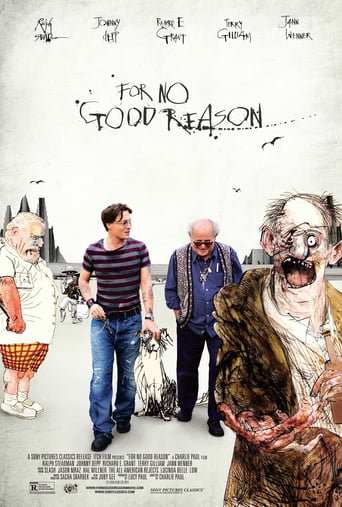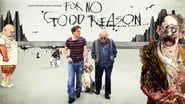jenperkins123
Johnny Depp, who is intriguing himself, seems to collect other intriguing people as friends. This documentary is about his friend Ralph Steadman, the artist who collaborated with Hunter S. Thompson and did a range of other fascinating work including illustrations for children's' books.Steadman demonstrates his creative process, discusses his love/hate relationship with Hunter S. Thompson, and talks about what he was and still is trying to achieve with his art. If you enjoy explorations into the intimate, fascinating details about artists and their work, you will love this film. If you've read Fear and Loathing in Las Vegas, it will be all the more interesting.I appreciated that Johnny Depp remained as invisible as possible, making sure Ralph Steadman took center stage. By the end of this movie, I was fascinated by the artist, and I am planning to view some of the books he has illustrated.Detailed documentaries about artists and their thought processes are not for everyone, but if you are fascinated by this type of film, you will not be disappointed in this one.
LeonLouisRicci
Documentaries about Artist are Not that Common, and they Should be. Most Artist Linger in Semi-Obscurity even if They have Attained a Modicum of Money, Fame, or Admiration and Recognition. A Good Bit of the Time there are Splashes in the Public Eye, but Unless the Work is in a Sort of Popular Culture Saturation, it is Unlikely that Any given Artist, Outside the Bubble of a Particular Field, Comic Books, for Example, a Particular Artist Remains Relatively Unknown.Documentaries can Flesh Out the Person Behind the Art, at Least a Little bit, and can Shed Some Insight and Light while giving a Platform for the Art to be Exposed in Heaps for Ninety Minutes or so. Aside, from a Coffee Table Book that Includes Pages and Pages of Artwork, a Docu-Film will most Likely be Seen by More People than Buy the Book.So here is Ralph Steadman. Who, You Say? Exactly. Unless You were a Reader of Rolling Stone Magazine in the Seventies, or a Fan of Gonzo Journalist Hunter S. Thompson, Steadman has Remained in the Aforementioned Obscurity. But that's About the Extent of His Explosion of Exposure.Not that it is Insignificant, much to the Contrary, He and the Good Doctor, Thompson, Defined Gonzo Journalism, and Tried to "Change the world!", a Phrase that Steadman Utters at Least Three Times in the Documentary and in the End, at Age 76, Seems Disappointed that Most of what He Tried to Change, Remains Unchanged.The Fancy Film from Director Charlie Paul is Filled with enough Interesting Anecdotes and Surprisingly Rare and Old Archival Footage, a lot with Hunter. It also Includes Interviews with Other Folks who have Worked with Steadman and it is all Anchored with Johnny Depp, Long Time Friend and Fan. Terry Gilliam's Movie, "Fear and Loathing in Las Vegas" (1998) is Based on the Book by Thompson that Included Illustrations by Steadman and may be the Artist Link to Moderns with the Most Resonance. Overall, a Must See Movie for Lovers of Art, the Sixties Counter Culture, Hunter S. Thompson, and to Get an Introduction to One of the Most Bizarre and Powerful Political Artists of Our Time. His Work and Some of His Unique Mystique and Technique, Much on Display Here, can be Admired and Studied.
maurice yacowar
11 Ways to Look at For No Good Reason1. Charlie Paul's film is about the life and work of Gonzo cartoonist Ralph Steadman. To make his case as an artist the film cites Picasso and Bacon, but his real progenitors are Hogarth and Grosz. Maybe Paul didn't trust his audience to know really old art history. 2. In his seminal partnership (see below) with Hunter S. Thompson Steadman pioneered the new style of journalism in which the reporter becomes the story. That begat today's newspapers where personal opinion columns drown out hard investigation. The new extreme is the internet where everyone can air an opinion — however tenuously connected to fact or to history — with equal authority. Check the debates on Gaza to see how hopeless this miasma of bigotry, misinformation and righteousness has become. (That's not in the film but neither am I.) 3. It's a fascinating demonstration of the process of art making. Still cartoons become animated. We watch a complex work grow out of a few improv splatters. For Steadman, the artist shouldn't know where the work will end up. He just starts something and follows it to its peculiar end. Making art is making a discovery. Or it should be. 4. It celebrates the freedom of art. Steadman violated every convention in the book, not just in art but in the manners of culture. Thus a gentle mild-mannered man could unfurl a massive attack upon bullying and the suppressive whims of authority. Nixon was a ripe subject. 5. That rebellion is specifically masculine here. For the splatter artist the ink is like the urine or semen the macho strut will spray at the world. Hunter and Ralph are the Butch and Sundance of especially the 70s countercultural scene. The couple are so tight we're surprised to learn Thompson had a wife, who was on the phone when he shot himself. Talk about a hangup. The film celebrates the artist as dominantly male, an obsolete but continuing myth. 6. It's incidentally about the nature of wildness or madness. Rolling Stone editor Jann Wenner surprisingly concludes Steadman was wilder than Thompson. The former's imagination took him to further out and darker places than the latter's pranks could. 7. It's an album of those heady 70s when William Burroughs wrote gonzo literature and presided like an Athenian god (of opiate dignity) over the counterculture. 8. It's about Johnny Depp's friendship with Steadman. The film is structured as the two friends' visit. Maybe pretty boy Depp will broaden this arcane documentary's box office. But he's a legitimate participant. Having played Thompson in a film his presence signifies Thompson's mythic afterlife, as his arms full of tattoos embody Steadman's ink paintings. In both senses Depp brings the idea into flesh. Well, into the image of the flesh. 9. It's a reminder that the realism of a documentary is essentially a pretence. This is about Steadman but it's very much a film with a point of view and with as many overlaid themes as any fictional drama would carry (see above). There is nothing objective or purely factual about this film, nor need there be. Just remember that in a documentary as in a fiction there is a calculated purpose, inferable from what is included and what is omitted. Also, some scenes are played with actors. In that spirit Steadman says his drawings distort the subject but remain true representations. 10. Does the explosive unconventional artist inevitably sell out? The master of violent indecorum lives on a posh country estate (that few cartoonists in real life could afford). How he got that pad is framed out. But the film has a suggestive narrative frame. It opens with a small image of a taped Steadman talking about the making of this film. The image swells to fill/become the whole screen. The last image is of a small cut-out Steadman standing in front of a picture of that estate. The image takes him from flat to 3-D but also from an image of the real to an image of the palpably artificial. This follows scenes of Steadman signing huge editions (over 800) of "prints" of his work. They are described as "originals" because they are individually signed and numbered. But that doesn't make them "originals." An original would be a work that is conceived and made specifically for its medium, e.g., lithography stone, silkscreen, woodcut, etching plate, etc. The vaguer "print" suggests these are photographic or digital reproductions of drawings, not originals at all. They are "after" an original, and consequently of reduced value. It's disappointing to see our profound rebel cashing in so cheaply. Not that the "prints" sell cheaply. He's charging for his signature not his art. In some distant cemetery I can hear Hunter S. Thompson spinning — but whether he's complaining or applauding I can't tell. 11. Then there's the title. Thompson would invite Steadman on an assignment "for no good reason." But there was a good reason — an offbeat adventure that might lead to experience and art and at the very least— as they played it — both men's swaggering display. But art is made for no good reason, for itself not for any more practical beyond. Unless of course you start selling your signature on its copies for big bucks. That's not a good enough reason. For more see www.yacowar.blogspot.com.
Ella Paul
I just watched an early screening and this film really works as the story of a visionary artist of his time, using animation and interviews the film zips along his timeline with humour and insight.Johnny Depp plays it straight brilliantly and some of the music really works with the pace of the film. i really recommend this film for anyone who is interested in the whole Gonzo idea. Richard E Grant-add words of insight Terry Gilliam and Jan Wenner add their bit but the real star of the film is Ralph himself. Telling stories and memories the great artist guides us through sometimes difficult observations of the way we have been conducting our lives, his savage pen perfectly accompanies these raw words of truth about poverty, America and his friends, a really entertaining watch.




